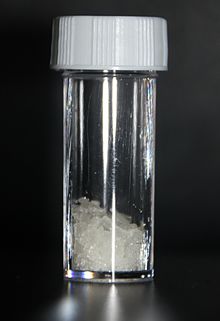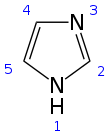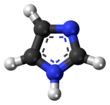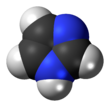Imidazole(ImH) is anorganic compoundwith the formula C3N2H4.It is a white or colourless solid that is soluble in water, producing a mildlyalkalinesolution. In chemistry, it is anaromaticheterocycle,classified as adiazole,and has non-adjacentnitrogenatoms inmeta-substitution.
| |||
| |||

| |||
| Names | |||
|---|---|---|---|
| Preferred IUPAC name
1H-Imidazole[1] | |||
| Other names
1,3-Diazole
Glyoxaline (archaic) | |||
| Identifiers | |||
3D model (JSmol)
|
|||
| 103853 | |||
| ChEBI | |||
| ChEMBL | |||
| ChemSpider | |||
| DrugBank | |||
| ECHA InfoCard | 100.005.473 | ||
| EC Number |
| ||
| 1417 | |||
| KEGG | |||
PubChemCID
|
|||
| RTECS number |
| ||
| UNII | |||
| UN number | 3263 | ||
CompTox Dashboard(EPA)
|
|||
| |||
| |||
| Properties | |||
| C3H4N2 | |||
| Molar mass | 68.077 g/mol | ||
| Appearance | White or pale yellow solid | ||
| Density | 1.23 g/cm3,solid | ||
| Melting point | 89 to 91 °C (192 to 196 °F; 362 to 364 K) | ||
| Boiling point | 256 °C (493 °F; 529 K) | ||
| 633 g/L | |||
| Acidity(pKa) | 6.95 (for theconjugate acid)[2] | ||
| UV-vis(λmax) | 206 nm | ||
| Structure | |||
| Monoclinic | |||
| Planar 5-membered ring | |||
| 3.61D | |||
| Hazards | |||
| Occupational safety and health(OHS/OSH): | |||
Main hazards
|
Corrosive | ||
| GHSlabelling:[4] | |||
  
| |||
| Danger | |||
| H302,H314,H360D | |||
| P263,P270,P280,P301+P310,P305+P351+P338,P308+P313[3] | |||
| Flash point | 146 °C (295 °F; 419 K) | ||
Except where otherwise noted, data are given for materials in theirstandard state(at 25 °C [77 °F], 100 kPa).
| |||
Many natural products, especiallyalkaloids,contain the imidazole ring. These imidazoles share the 1,3-C3N2ring but feature varied substituents. This ring system is present in important biological building blocks, such ashistidineand the related hormonehistamine.Many drugs contain an imidazole ring, such as certainantifungal drugs,thenitroimidazoleseries ofantibiotics,and the sedativemidazolam.[5][6][7][8][9]
When fused to apyrimidinering, it forms apurine,which is the most widely occurring nitrogen-containingheterocyclein nature.[10]
The name "imidazole" was coined in 1887 by the German chemistArthur Rudolf Hantzsch(1857–1935).[11]
Structure and properties
editImidazole is a planar 5-membered ring, that exists in two equivalenttautomericforms because hydrogen can be bound to one or anothernitrogenatom. Imidazole is a highly polar compound, as evidenced by itselectric dipole momentof 3.67D,[12]and is highly soluble in water. The compound is classified asaromaticdue to the presence of a planar ring containing 6π-electrons(a pair of electrons from the protonated nitrogen atom and one from each of the remaining four atoms of the ring). Someresonancestructures of imidazole are shown below:
Amphoterism
editImidazole isamphoteric,which is to say that it can function both as an acid and as a base. As an acid, thepKaof imidazole is 14.5, making it less acidic than carboxylic acids, phenols, and imides, but slightly more acidic than alcohols. The acidic proton is the one bound to nitrogen. Deprotonation gives the imidazolide anion, which is symmetrical. As a base, the pKaof the conjugate acid (cited as pKBH+to avoid confusion between the two) is approximately 7, making imidazole approximately sixty times more basic thanpyridine.The basic site is the nitrogen with the lone pair (and not bound to hydrogen). Protonation gives the imidazolium cation, which is symmetrical.
Preparation
editImidazole was first reported in 1858 by the German chemistHeinrich Debus,although various imidazole derivatives had been discovered as early as the 1840s. It was shown thatglyoxal,formaldehyde,andammoniacondense to form imidazole (glyoxaline, as it was originally named).[13]This synthesis, while producing relatively low yields, is still used for generatingC-substituted imidazoles.
In onemicrowavemodification, the reactants arebenzil,benzaldehydeandammoniainglacial acetic acid,forming 2,4,5-triphenylimidazole ( "lophine").[14]
Imidazole can be synthesized by numerous methods besides theDebus method.Many of these syntheses can also be applied to different substituted imidazoles and imidazole derivatives by varying thefunctional groupson the reactants. These methods are commonly categorized by which and how many bonds form to make the imidazole rings. For example, the Debus method forms the (1,2), (3,4), and (1,5) bonds in imidazole, using each reactant as a fragment of the ring, and thus this method would be a three-bond-forming synthesis. A small sampling of these methods is presented below.
Formation of one bond
editThe (1,5) or (3,4) bond can be formed by the reaction of animidateand an α-aminoaldehydeor α-aminoacetal.The example below applies to imidazole when R1= R2= hydrogen.
Formation of two bonds
editThe (1,2) and (2,3) bonds can be formed by treating a 1,2-diaminoalkane,at high temperatures, with analcohol,aldehyde,orcarboxylic acid.A dehydrogenating catalyst, such asplatinumonalumina,is required.
The (1,2) and (3,4) bonds can also be formed fromN-substituted α-aminoketones andformamidewith heat. The product will be a 1,4-disubstituted imidazole, but here since R1= R2= hydrogen, imidazole itself is the product. The yield of this reaction is moderate, but it seems to be the most effective method of making the 1,4 substitution.
Formation of four bonds
editThis is a general method that is able to give good yields for substituted imidazoles. In essence, it is an adaptation of the Debus method called theDebus-Radziszewski imidazole synthesis.The starting materials are substituted glyoxal, aldehyde, amine, and ammonia or an ammonium salt.[15]
Formation from other heterocycles
editImidazole can be synthesized by thephotolysisof1-vinyltetrazole.This reaction will give substantial yields only if the 1-vinyltetrazole is made efficiently from anorganotin compound,such as 2-tributylstannyltetrazole. The reaction, shown below, produces imidazole when R1= R2= R3= hydrogen.
Imidazole can also be formed in a vapor-phase reaction. The reaction occurs withformamide,ethylenediamine,and hydrogen overplatinumonalumina,and it must take place between 340 and 480 °C. This forms a very pure imidazole product.
- Van Leusen reaction[16]
TheVan Leusen reactioncan also be employed to form imidazoles starting fromTosMICand analdimine.The Van Leusen Imidazole Synthesis allows the preparation of imidazoles from aldimines by reaction with tosylmethyl isocyanide (TosMIC). The reaction has later been expanded to a two-step synthesis in which the aldimine is generated in situ: the Van Leusen Three-Component Reaction (vL-3CR).
Biological significance and applications
editImidazole is incorporated into many important biological compounds. The most pervasive is theamino acidhistidine,which has an imidazoleside-chain.Histidine is present in manyproteinsandenzymes,e.g. by binding metal cofactors, as seen inhemoglobin.
Imidazole-based histidine compounds play a very important role in intracellular buffering.[17]Histidine can bedecarboxylatedtohistamine.Histamine can causeurticaria(hives) when it is produced duringallergicreaction.
Imidazole substituents are found in many pharmaceuticals. Synthetic imidazoles are present in manyfungicidesandantifungal,antiprotozoal,andantihypertensivemedications. Imidazole is part of thetheophyllinemolecule, found in tea leaves and coffee beans, that stimulates thecentral nervous system.It is present in the anticancer medicationmercaptopurine,which combatsleukemiaby interfering withDNAactivities.
A number of substituted imidazoles, includingclotrimazole,are selective inhibitors ofnitric oxide synthase,which makes them interesting drug targets ininflammation,neurodegenerative diseases and tumors of the nervous system.[18][19]Other biological activities of the imidazolepharmacophorerelate to the downregulation of intracellularCa2+andK+fluxes, and interference with translation initiation.[20]
Pharmaceutical derivatives
editThe substituted imidazole derivatives are valuable in treatment of many systemicfungalinfections.[21]Imidazoles belong to the class ofazole antifungals,which includesketoconazole,miconazole,andclotrimazole.
For comparison, another group of azoles is the triazoles, which includesfluconazole,itraconazole,andvoriconazole.The difference between the imidazoles and the triazoles involves the mechanism of inhibition of thecytochrome P450 enzyme.The N3 of the imidazole compound binds to the heme iron atom of ferric cytochrome P450, whereas the N4 of the triazoles bind to the heme group. The triazoles have been shown to have a higher specificity for the cytochrome P450 than imidazoles, thereby making them more potent than the imidazoles.[22]
Some imidazole derivatives show effects on insects, for examplesulconazole nitrateexhibits a strong anti-feeding effect on thekeratin-digesting Australian carpet beetle larvaeAnthrenocerus australis,as doeseconazole nitratewith the common clothes mothTineola bisselliella.[23]
Industrial applications
editImidazole itself has few direct applications. It is instead a precursor to a variety of agrichemicals, includingenilconazole,climbazole,clotrimazole,prochloraz,andbifonazole.[24]
Coordination chemistry
editImidazole and its derivatives have high affinity for metal cations. One of the applications of imidazole is in the purification ofHis-taggedproteinsinimmobilised metal affinity chromatography(IMAC). Imidazole is used to elute tagged proteins bound tonickelionsattached to the surface of beads in thechromatographycolumn. An excess of imidazole is passed through the column, which displaces the His-tag from nickel coordination, freeing the His-tagged proteins.
Use in biological research
editImidazole is a suitable buffer for pH 6.2 to 7.8,.[25]Pure imidazole has essentially no absorbance at protein relevant wavelengths (280 nm),[26][27]however lower purities of imidazole can give notable absorbance at 280 nm. Imidazole can interfere with theLowry protein assay.[28]
Imidazole is often used in protein purification, where recombinant proteins with polyhistidine tags are immobilized onto nickel resins and eluted with a high imidazole concentration.
Salts of imidazole
editSalts of imidazole where the imidazole ring is thecationare known as imidazolium salts (for example, imidazoliumchlorideornitrate).[29]These salts are formed from theprotonationor substitution atnitrogenof imidazole. These salts have been used asionic liquidsand precursors tostable carbenes.Salts where a deprotonated imidazole is ananionare also well known; these salts are known asimidazolates(for example, sodium imidazolate, NaC3H3N2).
Related heterocycles
edit- Benzimidazole,an analog with a fusedbenzenering
- Dihydroimidazoleor imidazoline, an analog where the 4,5-double bondis saturated
- Pyrrole,an analog with only onenitrogenatomin position 1
- Oxazole,an analog with the nitrogen atom in position 1 replaced byoxygen
- Thiazole,an analog with the nitrogen atom in position 1 replaced bysulfur
- Pyrazole,an analog with two adjacentnitrogenatoms
- Triazoles,analogs with three nitrogen atoms
Safety
editImidazole has low acute toxicity as indicated by theLD50of 970 mg/kg (Rat, oral).[24]
See also
edit- 1-Methylimidazole
- 4-Methylimidazole
- Imidazoline(dihydroimidazole)
References
edit- ^"Front Matter".Nomenclature of Organic Chemistry: IUPAC Recommendations and Preferred Names 2013 (Blue Book).Cambridge:The Royal Society of Chemistry.2014. p. 140.doi:10.1039/9781849733069-FP001.ISBN978-0-85404-182-4.
- ^Walba, H.; Isensee, R. W. (1961). "Acidity constants of some arylimidazoles and their cations".J. Org. Chem.26(8): 2789–2791.doi:10.1021/jo01066a039.
- ^"Imidazole".molekula.com.Molekula Group.Archivedfrom the original on 2018-10-19.Retrieved2018-10-19.
- ^"Imidazole".pubchem.ncbi.nlm.nih.gov.Archivedfrom the original on 10 May 2023.Retrieved17 February2024.
- ^Karitzky, A. R.;Rees, C.W.R.; Scriven, E.F.V. (1984).Comprehensive Heterocyclic Chemistry.Vol. 5. pp. 469–498.ISBN978-0-08-042072-1.
- ^Grimmett, M. Ross (1997).Imidazole and Benzimidazole Synthesis.Academic Press.ISBN978-0-08-053445-9.
- ^Brown, E. G. (1998).Ring Nitrogen and Key Biomolecules.Kluwer Academic Press.ISBN978-94-011-4906-8.
- ^Pozharskii, A. F.; et al. (1997).Heterocycles in Life and Society.John Wiley & Sons.ISBN978-0-471-96033-1.
- ^Gilchrist, T. L. (1985).Heterocyclic Chemistry.Bath Press.ISBN978-0-582-01421-3.
- ^Rosemeyer, H. (2004). "The Chemodiversity of Purine as a Constituent of Natural Products".Chemistry & Biodiversity.1(3): 361–401.doi:10.1002/cbdv.200490033.PMID17191854.S2CID12416667.
- ^Hantzsch, A. and Weber, J. H. (1887)"Ueber Verbindungen des Thiazols (Pyridins der Thiophenreihe)"Archived2020-05-30 at theWayback Machine(On compounds of thiazole (pyridines of the thiophene series),Berichte der deutschen chemischen Gesellschaft,20:3118–3132, see p. 3119. See also: Hantzsch, A. (1888)"Allegemeine Bemerkungen über Azole"Archived2020-05-30 at theWayback Machine(General observations about azoles),Annalen der Chemie,249:1–6. Hantzsch proposed a reform of the nomenclature of azole compounds, including a proposal to call the heterocyclic ring C3H3(NH)N "imidazole"; see pp. 2 and 4.
- ^Christen, Dines; Griffiths, John H.; Sheridan, John (1981)."The Microwave Spectrum of Imidazole; Complete Structure and the Electron Distribution from Nuclear Quadrupole Coupling Tensors and Dipole Moment Orientation".Zeitschrift für Naturforschung A.36(12): 1378–1385.Bibcode:1981ZNatA..36.1378C.doi:10.1515/zna-1981-1220.S2CID3522351.
- ^Debus, Heinrich (1858)."Ueber die Einwirkung des Ammoniaks auf Glyoxal"[On the reaction of ammonia upon glyoxal].Annalen der Chemie und Pharmacie.107(2): 199–208.doi:10.1002/jlac.18581070209.Archivedfrom the original on 2020-05-30.Retrieved2016-10-01.From p. 205:"Die gereinigte Substanz stellt das oxalsaure Salz einer Basis dar, die ich mit Glyoxalin bezeichenen werde."(The purified substance constitutes the oxalic salt of a base, which I will designate as "glyoxaline".)
- ^Crouch, R. David; Howard, Jessica L.; Zile, Jennifer L.; Barker, Kathryn H. (2006). "Microwave-Mediated Synthesis of Lophine: Developing a Mechanism To Explain a Product".J. Chem. Educ.83(11): 1658.Bibcode:2006JChEd..83.1658C.doi:10.1021/ed083p1658.
- ^US patent 6,177,575,Arduengo, A. J.,"Process for Manufacture of Imidazoles", issued 2001-01-23
- ^Van Leusen, Albert M.; Wildeman, Jurjen; Oldenziel, Otto H. (1977). "Chemistry of sulfonylmethyl isocyanides. 12. Base-induced cycloaddition of sulfonylmethyl isocyanides to carbon, nitrogen double bonds. Synthesis of 1,5-disubstituted and 1,4,5-trisubstituted imidazoles from aldimines and imidoyl chlorides".Journal of Organic Chemistry.42(7): 1153–1159.Bibcode:1977JOrgC..42.1153A.doi:10.1021/jo00427a012.
- ^Hochachka, P. W.; Somero, G. N. (2002).Biochemical Adaptation: Mechanisms and Process in Physiological Evolution.New York: Oxford University Press.
- ^Castaño, T.; Encinas, A.; Pérez, C.; Castro, A.; Campillo, N. E.; Gil, C. (2008)."Design, synthesis, and evaluation of potential inhibitors of nitric oxide synthase"(PDF).Bioorg. Med. Chem.(Submitted manuscript).16(11): 6193–6206.doi:10.1016/j.bmc.2008.04.036.hdl:10261/87090.PMID18477512.Archived(PDF)from the original on 2023-03-06.Retrieved2018-07-24.
- ^Bogle, R. G.; Whitley, G. S.; Soo, S. C.; Johnstone, A. P.; Vallance, P. (1994)."Effect of anti-fungal imidazoles on mRNA levels and enzyme activity of inducible nitric oxide synthase".Br. J. Pharmacol.111(4): 1257–1261.doi:10.1111/j.1476-5381.1994.tb14881.x.PMC1910171.PMID7518297.
- ^Khalid, M. H.; Tokunaga, Y.; Caputy, A. J.; Walters, E. (2005). "Inhibition of tumor growth and prolonged survival of rats with intracranial gliomas following administration of clotrimazole".J. Neurosurg.103(1): 79–86.doi:10.3171/jns.2005.103.1.0079.PMID16121977.
- ^Leon Shargel (2007).Comprehensive Pharmacy Review(6th ed.). Lippincott Williams & Wilkins. p. 930.ISBN9780781765619.
- ^Davis, Jennifer L.; Papich, Mark G.; Heit, Mark C. (2009)."Chapter 39: Antifungal and Antiviral Drugs".In Riviere, Jim E.; Papich, Mark G. (eds.).Veterinary Pharmacology and Therapeutics(9th ed.). Wiley-Blackwell. pp. 1019–1020.ISBN978-0-8138-2061-3.
- ^Sunderland, M. R.; Cruickshank, R. H.; Leighs, S. J. (2014). "The efficacy of antifungal azole and antiprotozoal compounds in protection of wool from keratin-digesting insect larvae".Textile Res. J.84(9): 924–931.doi:10.1177/0040517513515312.S2CID135799368.
- ^abEbel, K., Koehler, H., Gamer, A. O., & Jäckh, R. (2002). "Imidazole and Derivatives".Ullmann's Encyclopedia of Industrial Chemistry.Weinheim: Wiley-VCH.doi:10.1002/14356007.a13_661.ISBN978-3527306732.
{{cite encyclopedia}}:CS1 maint: multiple names: authors list (link) - ^Dawson, R. M. C. (1986).Data for biochemical research.Oxford: Clarendon Press. p. 325.ISBN978-0-19-855299-4.OCLC11865673.
- ^"1H-Imidazole".Archivedfrom the original on 25 April 2021.Retrieved13 May2021.
- ^"Optimizing Purification of Histidine-Tagged Proteins".Archivedfrom the original on 13 May 2021.Retrieved13 May2021.
- ^Molina, F; Rueda, A; Bosque-Sendra, J.M; Megias, L (1996). "Determination of proteins in the presence of imidazole buffers".Journal of Pharmaceutical and Biomedical Analysis.14(3). Elsevier BV: 273–280.doi:10.1016/0731-7085(95)01615-5.ISSN0731-7085.PMID8851751.
- ^Zolfigol, Mohammad A.; Khazaei, Ardeshir; Moosavi-Zare, Ahmad R.; Zare, Abdolkarim; Kruger, Hendrik G.; Asgari, Zhila; Khakyzadeh, Vahid; Kazem-Rostami, Masoud (2012-04-06). "Design of Ionic Liquid 3-Methyl-1-sulfonic Acid Imidazolium Nitrate as Reagent for the Nitration of Aromatic Compounds by in Situ Generation of NO2 in Acidic Media".The Journal of Organic Chemistry.77(7): 3640–3645.doi:10.1021/jo300137w.ISSN0022-3263.PMID22409592.



